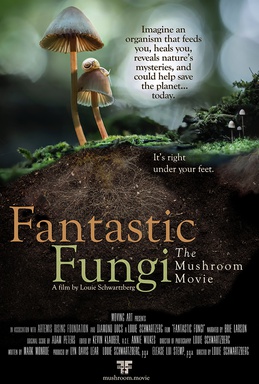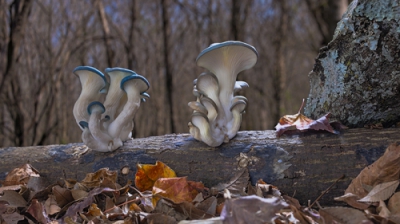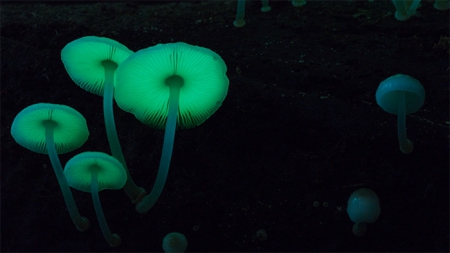By Connor Yearsley
 Fungi
frequently are forgotten and taken for granted. In fact, without knowing it,
people trod over about 300 miles of sprawling fungi with each step. That is
according to Fantastic Fungi: The Magic
Beneath Us, a documentary film that was released in the United States in
October 2019. The film currently holds a 100% rating on review aggregate
websites Rotten Tomatoes and Flixster. Fungi
frequently are forgotten and taken for granted. In fact, without knowing it,
people trod over about 300 miles of sprawling fungi with each step. That is
according to Fantastic Fungi: The Magic
Beneath Us, a documentary film that was released in the United States in
October 2019. The film currently holds a 100% rating on review aggregate
websites Rotten Tomatoes and Flixster.
Directed
by Louie Schwartzberg, written by Mark Monroe, and narrated by Brie Larson, the
film features interviews with a host of notable naturalists and scientists,
including Andrew Weil, MD, and Dennis McKenna, PhD. Renowned mycologist (fungi
expert) Paul Stamets, however, is definitely the star. Throughout, his
enthusiasm and passion for fungi are contagious, and the insights he shares reflect
a lifetime of research and knowledge.
The
film is replete with stunning visuals and cinematography that may be worth the
watch alone. This includes fascinating time lapses of fungi growing and
breaking down everything from fruit to termites to a mouse. Kaleidoscopic
geometric patterns occur throughout and presumably are meant to elicit the
feeling of using the psychedelic compound psilocybin (derived primarily from
the fungal genus Psilocybe [Hymenogastraceae]). In key places, the music by Adam
Peters elevates and reinforces the mood.
In the
film, Stamets says that fungi “can heal you. They can feed you. They can kill
you.” Though the focus is mostly on the positive aspects of fungi and
mycophilia, or the love of fungi, it is admitted that mycophobia, or a fear of
fungi, exists too, perhaps because of their association with death, decay, and disease.
The film emphasizes that while fungi do represent the end of life, they also
represent the beginning of life and enable restoration, rejuvenation, and
resurrection. Described as nature’s “digestive tract,” fungi help generate
life-giving soils.
A
recurring theme is how fungi are omnipresent on one hand but “hidden” from view
on the other. In fact, humans inhale fungal spores with each breath, from their
first breath to their last. Fungi are out of sight, out of mind, and typically much
less conspicuous than members of the plant and animal kingdoms. The
interconnectedness of fungi, plants, and animals is also explored. For
instance, nutrients can pass from tree to tree through underground fungal
“passageways,” and, after trees remove carbon dioxide from the atmosphere, much
of that carbon travels underground, where it is stored by fungi. Without fungi,
plant life would choke the Earth, the film explains.
 The
incredible diversity of fungi is also a central topic, from luminescent and
purple fungi to the Earth’s largest (by area) known living organism: a specimen
of Armillaria ostoyae (Physalacriaceae) called the “Humongous Fungus” in
Oregon. “Pando,” a clonal colony of quaking aspen (Populus tremuloides, Salicaceae) trees in Utah, however, is considered
the largest known living organism by mass. The
incredible diversity of fungi is also a central topic, from luminescent and
purple fungi to the Earth’s largest (by area) known living organism: a specimen
of Armillaria ostoyae (Physalacriaceae) called the “Humongous Fungus” in
Oregon. “Pando,” a clonal colony of quaking aspen (Populus tremuloides, Salicaceae) trees in Utah, however, is considered
the largest known living organism by mass.
Fungi,
which produce chemical compounds that are not produced by other organisms, are
proposed as sources of viable solutions to many of the world’s biggest problems,
from human to environmental health concerns. Stamets stresses the importance of
preserving old-growth forests as repositories of fungal resources. As
explained, fungi can break down oil and filter water. And lion’s mane (Hericium erinaceus, Hericiaceae) may be able to promote the regeneration
of nerve cells, which suggests possible benefits for people with Alzheimer’s
disease, for example. These and a wealth of other abilities led some people in
the film to describe feeling empowered by fungi.
The use
of fungi to reduce viruses in honeybees, which was covered extensively in HerbalGram issue 125,1 is
mentioned briefly, but I would have liked a longer segment on this important
and timely research. This could have been an opportunity for some great
videography showing the bees and fungi in action. The film also could have
discussed the potential importance of a fungus’ substrate (the material on or
from which an organism lives, grows, and/or obtains its nourishment), and how
it can impact the fungus’ chemistry and value.
Much of
the second half is dedicated to psilocybin. As explained, psilocybin can induce
synesthesia, or a blending of the senses (e.g., hearing colors). The film
suggests that psilocybin use by ancestors of modern humans may have played a
role in the development of the modern human brain. The recent history of
psilocybin is covered, from its introduction into popular culture by the
ethnomycologist Robert Gordon Wasson (1898-1986), to its stigmatization and,
recently, the resurgence of interest in its therapeutic use.
The
testimonies of two end-stage cancer patients, a man and a woman, are
particularly meaningful. They participated in recent clinical trials that
assessed the effects of psilocybin on depression and anxiety associated with existential
distress.2 The man  said that just a single dose of psilocybin made
him more comfortable with living because he was no longer afraid of dying.
Despite the stigma against psilocybin, given its hallucinatory effects, after
hearing these testimonies, it is difficult to deny that it can have profound,
life-changing effects for some people in some circumstances, whether extenuating
or not. In fact, the film explains that many study participants ranked their
psilocybin session among the most meaningful experiences of their lives, and
many compared it to the birth of their first-born child. said that just a single dose of psilocybin made
him more comfortable with living because he was no longer afraid of dying.
Despite the stigma against psilocybin, given its hallucinatory effects, after
hearing these testimonies, it is difficult to deny that it can have profound,
life-changing effects for some people in some circumstances, whether extenuating
or not. In fact, the film explains that many study participants ranked their
psilocybin session among the most meaningful experiences of their lives, and
many compared it to the birth of their first-born child.
As this review may just scratch the surface
of the film, the film itself may just scratch the surface of the fungi kingdom,
which is described as a “frontier of knowledge.” This is not a criticism, at
all, but more a testament to the subject. In fact, perhaps it speaks to how
much people take fungi for granted and how little is known about them that they
could be summarized so well in Fantastic Fungi, which runs only 81
minutes. To summarize plants, for example, in one documentary of equal length
would seem impossible, even though fungal species greatly outnumber plant
species and have existed longer than land plants.3 After watching Fantastic
Fungi, maybe more people will become mycophiles; be left with a greater
appreciation of the complexity, diversity, and versatility of these organisms;
and be inspired to expand the knowledge-base and find the next fungal-related
scientific breakthrough.
Schwartzberg
said he loves taking audiences on journeys through time and scale (oral
communication, March 12, 2020). “I really try to share the wonders of nature’s
intelligence, by making the invisible visible and using cinematic techniques
like time lapse, slo-mo, micro, and macro,” he said. “By showing nature’s beauty,
rhythm, and patterns, I want people to fall in love with nature, because if
people fall in love with it, then they will protect it. We need that to create
a sustainable future for our planet.
 “One
thing that I discovered [while] making Fantastic
Fungi is that the underground mycelial network is a beautiful economy where
nutrients are shared for ecosystems to flourish,” Schwartzberg added. “I hope
audiences will take away [the idea] that communities survive better than
individuals. Nothing in nature lives alone. This could be a model for us to
replicate in our cultural and political society. Sharing is nature’s way of
doing things.” “One
thing that I discovered [while] making Fantastic
Fungi is that the underground mycelial network is a beautiful economy where
nutrients are shared for ecosystems to flourish,” Schwartzberg added. “I hope
audiences will take away [the idea] that communities survive better than
individuals. Nothing in nature lives alone. This could be a model for us to
replicate in our cultural and political society. Sharing is nature’s way of
doing things.”
The
film presented challenges. “Shooting time lapse is a very slow and difficult
process filled with a lot of failure,” Schwartzberg said. “It takes a
tremendous amount of patience. I have had cameras running non-stop for decades
in my studio. And all of that time is squeezed into hours of film. So, it is very
challenging, but the results are breathtaking.”
Stamets is “very pleased” with the film and
would consider making another with Schwartzberg (email,
March 5, 2020).
“Louie approached me after seeing my lecture at a
Bioneers conference in the mid-1990s,” Stamets wrote. “He showed me some time
lapses that blew my mind. After I [later] committed, it took [more than a
decade]! I wanted to show how we are all interconnected via
mycelia [the vegetative part of a fungus’ life cycle that consists of many
threadlike tubes], and
that mycelia have the resources to help us and our ecosystems
survive and improve. We share a great consciousness with nature, and mushrooms
are a portal. We need to reconnect with each other and with nature. That most
showings of the film were sold out reflects the hunger that has built up for
the need to understand the meaning of our being.”
The
film is available on www.fantasticfungi.com for digital download
($14.99) and streaming ($4.99). Image credits All images courtesy of Moving Art. Top to bottom:
Movie poster
Blue oyster fungus (Pleurotus ostreatus, Pleurotaceae). Credit: Upthink
Mycena chlorophos (Mycenaceae). Credit: Steve Axford
Pink oyster fungus (P. salmoneo-stramineus). Credit: Upthink
References
- Yearsley C. Can
Fungi Ease Disease in Bees? HerbalGram.
2020;125:66-73. Available at: http://cms.herbalgram.org/herbalgram/issue125/hg125-feat-bee.html. Accessed March 30, 2020.
- Yearsley C.
Psilocybin Reduces Symptoms of Anxiety and Depression in Patients with Cancer
in Two Clinical Trials. HerbalGram. 2017;114:38-42.
Available at: http://cms.herbalgram.org/herbalgram/issue114/hg114-resrvw-psilocy.html. Accessed March 30, 2020.
- Heckman DS, Geiser DM, Eidell BR, Stauffer
RL, Kardos NL, Hedges SB. Molecular evidence for the early colonization of land
by fungi and plants. Science. 2001;293(5532):1129-1133. doi: 10.1126/science.1061457.
|